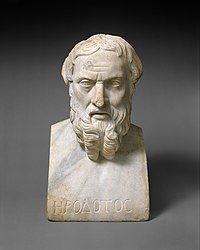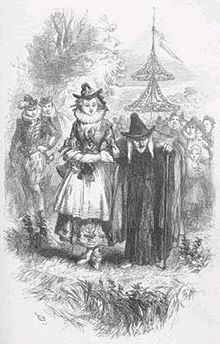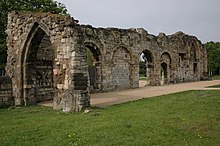Portal:History
The History Portal

Herodotus (c. 484 BC – c. 425 BC) is often
considered the "father of history"
History (derived from Ancient Greek ἱστορία (historía) 'inquiry; knowledge acquired by investigation') is the systematic study and documentation of the human past. History is an academic discipline which uses a narrative to describe, examine, question, and analyse past events, and investigate their patterns of cause and effect. Historians debate which narrative best explains an event, as well as the significance of different causes and effects. Historians debate the nature of history as an end in itself, and its usefulness in giving perspective on the problems of the present.
The period of events before the invention of writing systems is considered prehistory. "History" is an umbrella term comprising past events as well as the memory, discovery, collection, organization, presentation, and interpretation of these events. Historians seek knowledge of the past using historical sources such as written documents, oral accounts or traditional oral histories, art and material artefacts, and ecological markers.
Stories common to a particular culture, but not supported by external sources (such as the tales surrounding King Arthur), are usually classified as cultural heritage or legends. History differs from myth in that it is supported by verifiable evidence. However, ancient cultural influences have helped create variant interpretations of the nature of history, which have evolved over the centuries and continue to change today. The modern study of history is wide-ranging, and includes the study of specific regions and certain topical or thematic elements of historical investigation. History is taught as a part of primary and secondary education, and the academic study of history is a major discipline in universities.
Herodotus, a 5th-century BCE Greek historian, is often considered the "father of history", as one of the first historians in the Western tradition, though he has been criticized as the "father of lies". Along with his contemporary Thucydides, he helped form the foundations for the modern study of past events and societies. Their works continue to be read today, and the gap between the culture-focused Herodotus and the military-focused Thucydides remains a point of contention or approach in modern historical writing. In East Asia a state chronicle, the Spring and Autumn Annals, was reputed to date from as early as 722 BCE, though only 2nd-century BCE texts have survived. The title "father of history" has also been attributed, in their respective societies, to Sima Qian, Ibn Khaldun, and Kenneth Dike. (Full article...)
The Battle of Trapani took place on 23 June 1266 off Trapani, Sicily, between the fleets of the Republic of Genoa and the Republic of Venice, as part of the War of Saint Sabas (1256–1270). During the war, the Venetians held the upper hand in naval confrontations, forcing the Genoese to resort to commerce raiding and avoiding fleet battles. In the 1266 campaign, the Genoese had an advantage in numbers, but this was not known to the Genoese commander, Lanfranco Borbonino. As a result, the Genoese tarried at Corsica until the end of May. The Venetian fleet under Jacopo Dondulo, was left to sail back and forth awaiting the appearance of the Genoese fleet in the waters around southern Italy and Sicily. Fearing that the other side had more ships, both sides reinforced their fleets with additional ships, but the Genoese retained a small numerical advantage.
The two fleets met near Trapani in Sicily on 22 June. After learning of the Venetian fleet's smaller size, the Genoese war council resolved to attack, but during the night Borbonino reversed the decision and instead ordered his ships to take up a defensive position, bound together with chains, near the shore. As the Venetian fleet attacked the next day, many of the Genoese crews, mostly hired foreigners, lost heart and abandoned their ships. The battle was a crushing Venetian victory, as they sank or captured the entire Genoese fleet. On their return to Genoa, Borbonino and most of his captains were tried and fined large sums for cowardice. Despite the loss, Genoa continued the war, in which neither side was able to gain a decisive advantage, until it was ended through French mediation in 1270. (Full article...)
USS New Ironsides was a wooden-hulled broadside ironclad built for the United States Navy during the American Civil War. The ship spent most of her career blockading the Confederate ports of Charleston, South Carolina, and Wilmington, North Carolina, in 1863–65. New Ironsides bombarded the fortifications defending Charleston in 1863 during the First and Second Battles of Charleston Harbor. At the end of 1864 and the beginning of 1865 she bombarded the defenses of Wilmington in the First and Second Battles of Fort Fisher.
Although she was struck many times by Confederate shells, gunfire never significantly damaged the ship or injured the crew. Her only casualty in combat occurred when she was struck by a spar torpedo carried by the CSS David. Eight crewmen were awarded the Medal of Honor for their actions during the Second Battle of Fort Fisher in 1865. The ship was destroyed by fire in 1865 after she was placed in reserve. (Full article...)
Phan Đình Phùng (Vietnamese: [faːn ɗîŋ̟ fûŋm]; 1847 – January 21, 1896) was a Vietnamese revolutionary who led rebel armies against French colonial forces in Vietnam. He was the most prominent of the Confucian court scholars involved in anti-French military campaigns in the 19th century and was cited after his death by 20th-century nationalists as a national hero. He was renowned for his uncompromising will and principles—on one occasion, he refused to surrender even after the French had desecrated his ancestral tombs and had arrested and threatened to kill his family.
Born into a family of mandarins from Hà Tĩnh Province, Phan continued his ancestors' traditions by placing first in the metropolitan imperial examinations in 1877. Phan quickly rose through the ranks under Emperor Tự Đức of the Nguyễn dynasty, gaining a reputation for his integrity and uncompromising stance against corruption. Phan was appointed as the Imperial Censor, a position that allowed him to criticise his fellow mandarins and even the emperor. As the head of the censorate, Phan's investigations led to the removal of many incompetent or corrupt mandarins. (Full article...)
The capture of Fort Ticonderoga occurred during the American Revolutionary War on May 10, 1775, when a small force of Green Mountain Boys led by Ethan Allen and Colonel Benedict Arnold surprised and captured the fort's small British garrison. The cannons and other armaments at Fort Ticonderoga were later transported to Boston by Colonel Henry Knox in the noble train of artillery and used to fortify Dorchester Heights and break the standoff at the siege of Boston.
Capture of the fort marked the beginning of offensive action taken by the Americans against the British. After seizing Ticonderoga, a small detachment captured the nearby Fort Crown Point on May 11. Seven days later, Arnold and 50 men raided Fort Saint-Jean on the Richelieu River in southern Quebec, seizing military supplies, cannons, and the largest military vessel on Lake Champlain. (Full article...)

Macedonia (/ˌmæsɪˈdoʊniə/ MASS-ih-DOH-nee-ə; Greek: Μακεδονία, Makedonía), also called Macedon (/ˈmæsɪdɒn/ MASS-ih-don), was an ancient kingdom on the periphery of Archaic and Classical Greece, which later became the dominant state of Hellenistic Greece. The kingdom was founded and initially ruled by the royal Argead dynasty, which was followed by the Antipatrid and Antigonid dynasties. Home to the ancient Macedonians, the earliest kingdom was centered on the northeastern part of the Greek peninsula, and bordered by Epirus to the southwest, Illyria to the northwest, Paeonia to the north, Thrace to the east and Thessaly to the south.
Before the 4th century BC, Macedonia was a small kingdom outside of the area dominated by the great city-states of Athens, Sparta and Thebes, and briefly subordinate to Achaemenid Persia. During the reign of the Argead king Philip II (359–336 BC), Macedonia subdued mainland Greece and the Thracian Odrysian kingdom through conquest and diplomacy. With a reformed army containing phalanxes wielding the sarissa pike, Philip II defeated the old powers of Athens and Thebes in the Battle of Chaeronea in 338 BC. Philip II's son Alexander the Great, leading a federation of Greek states, accomplished his father's objective of commanding the whole of Greece when he destroyed Thebes after the city revolted. During Alexander's subsequent campaign of conquest, he overthrew the Achaemenid Empire and conquered territory that stretched as far as the Indus River. For a brief period, his Macedonian Empire was the most powerful in the world – the definitive Hellenistic state, inaugurating the transition to a new period of Ancient Greek civilization. Greek arts and literature flourished in the new conquered lands and advances in philosophy, engineering, and science spread across the empire and beyond. Of particular importance were the contributions of Aristotle, tutor to Alexander, whose writings became a keystone of Western philosophy. (Full article...)
The light tank Mk VII (A17), also known as the Tetrarch, was a British light tank produced by Vickers-Armstrongs in the late 1930s and used during the Second World War. The Tetrarch was the latest in the line of light tanks built by the company for the British Army. It improved upon its predecessor, the Light Tank Mk VIC, by introducing the extra firepower of a 2-pounder gun. The War Office ordered 70 tanks, an order that eventually increased to 220. Production was delayed by several factors and only 100 to 177 of the tanks were produced.
The design flaws of the tank, combined with the decision by the War Office not to use light tanks in British armoured divisions, ruled out the use of Tetrarchs in the North African Campaign. The majority of the tanks remained in Britain, although twenty were sent to the USSR as part of Lend-Lease. In early 1941, the Royal Armoured Corps formed three squadrons for use in overseas amphibious operations, one of which was equipped with Tetrarchs. In May 1942, a small number of Tetrarchs formed part of the British force which participated in Operation Ironclad, the invasion of Madagascar. In June 1942, Tetrarchs were attached to the 1st Airborne Division after it was decided that the design allowed its use as an air-portable light tank to support British airborne forces. The Tetrarchs were transported and landed in specially-designed General Aircraft Hamilcar gliders. A lack of gliders prevented their participation in the Allied invasion of Sicily in 1943; instead they were attached to the new 6th Airborne Division and became part of the 6th Airborne Armoured Reconnaissance Regiment. (Full article...)

The trials of the Pendle witches in 1612 are among the most famous witch trials in English history, and some of the best recorded of the 17th century. The twelve accused lived in the area surrounding Pendle Hill in Lancashire, and were charged with the murders of ten people by the use of witchcraft. All but two were tried at Lancaster Assizes on 18–19 August 1612, along with the Samlesbury witches and others, in a series of trials that have become known as the Lancashire witch trials. One was tried at York Assizes on 27 July 1612, and another died in prison. Of the eleven who went to trial – nine women and two men – ten were found guilty and executed by hanging; one was found not guilty.
The official publication of the proceedings by the clerk to the court, Thomas Potts, in his The Wonderfull Discoverie of Witches in the Countie of Lancaster, and the number of witches hanged together – nine at Lancaster and one at York – make the trials unusual for England at that time. It has been estimated that all the English witch trials between the early 15th and early 18th centuries resulted in fewer than 500 executions; this series of trials accounts for more than two per cent of that total. (Full article...)
The Northrop/McDonnell Douglas YF-23 is an American single-seat, twin-engine, stealth fighter technology demonstrator prototype designed for the United States Air Force (USAF). The design team, with Northrop as the prime contractor, was a finalist in the USAF's Advanced Tactical Fighter (ATF) demonstration/validation competition, battling the YF-22 team for full-scale development and production. Two YF-23 prototypes were built.
In the 1980s, the USAF began looking for a replacement for its F-15 fighter aircraft to more effectively counter emerging threats such as the Soviet Union's advanced Sukhoi Su-27 and Mikoyan MiG-29. Several companies submitted design proposals; the USAF selected proposals from Northrop and Lockheed for demonstration/validation. Northrop teamed up with McDonnell Douglas to develop the YF-23, while Lockheed, Boeing, and General Dynamics developed the YF-22. The YF-23 was stealthier and faster, but less agile than its competitor. After a four-year development and evaluation process, the YF-22 team was announced as the winner in 1991 and developed the F-22 Raptor, which first flew in 1997 and entered service in 2005. The U.S. Navy considered using a naval version of the ATF as a replacement for the F-14, but these plans were later canceled due to costs. (Full article...)












































